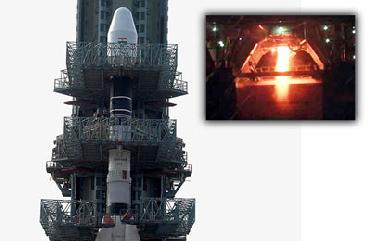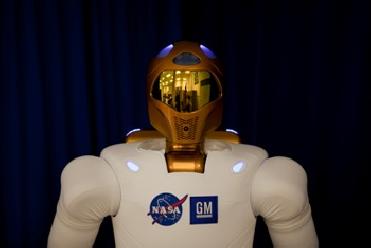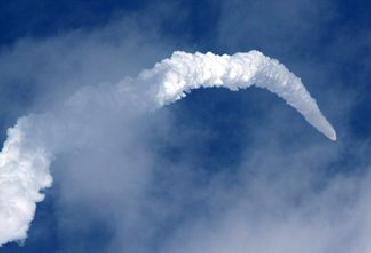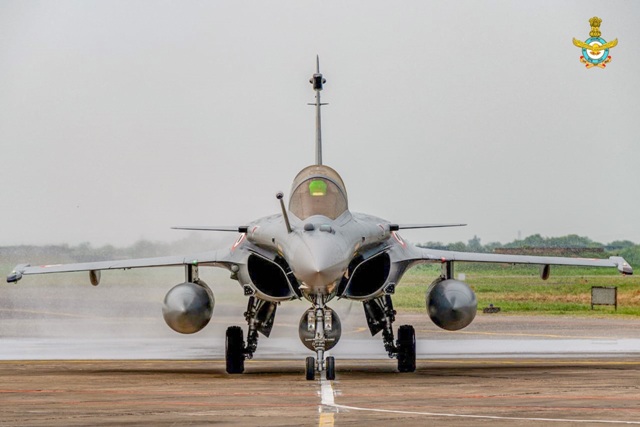
ISRO's GSLV-D3 and the indigenous cryogenic engine (inset).
India on Thursday launched its Geosynchronous Satellite Launch Vehicle, GSLV - D3 which during its flight deviated from its path and plunged into the Bay of Bengal. This happened after the indigenous cryogenic engine ignited on time after the lift off but the two vernier engines of the cryogenic stage appeared not to have ignited.
The satellite launch was ISRO's ambitious quest to achieve total independence in the crucial cryogenic technology.
Introduction to GSLV-D3
The Geosynchronous Satellite Launch Vehicle (GSLV) is an expendable launch system operated by the Indian Space Research Organisation (ISRO). It is capable of placing INSAT–II class of satellites (2000 – 2,500 kg) into Geosynchronous Transfer Orbit (GTO).
GSLV-D3 is the sixth flight of ISRO's Geosynchronous Satellite Launch Vehicle (GSLV) as well as its third developmental flight and was designated as GSLV MkII.
GSLV-D3 for the first time carried ISRO's indigenously developed Cryogenic Upper Stage (CUS) for flight testing. In the past five flights of GSLV, Cryogenic Stages (CS) procured from Russia were used.
The 50 m tall GSLV, with a lift-off mass of 416 ton, is a three-stage vehicle with solid, liquid and cryogenic stages.
The solid core motor of the first stage of GSLV is one of the largest rocket motors in the world and uses 138 tons of Hydroxyl Terminated Poly-Butadiene (HTPB) based propellant (fuel-oxidiser combination).
The second stage (carrying 38.5 tons of propellant ) as well as the four strap-on motors of the first stage (each carrying 42 tons of propellant) use liquid propellant 'Vikas' engine burning UH25 and Nitrogen Tetroxide.
The third stage of GSLV carrying 12.5 tons of propellants is a cryogenic stage that uses liquid Hydrogen as fuel and liquid Oxygen as oxidiser.
During the flight, GSLV-D3 was set to launch GSAT-4 communication satellite that carries the communication and navigation payloads, into GTO. GSLV, carrying the indigenous CUS. It was designated as GSLV MkII.
ISRO's Cryogenic Upper Stage (CUS)
ISRO had taken up development of cryogenic stage to achieve self-reliance in the technology.
A cryogenic engine is one which is powered by liquefied oxygen and hydrogen and can hurl large communication satellites into orbit.
Cryogenic Stage is a rocket stage that is much more efficient and provides more thrust for every kilogram of propellant it burns compared to solid and earth-storable liquid propellant stages.
The indigenous CUS is powered by a regeneratively cooled cryogenic engine, which works on staged combustion cycle developing a thrust of 69.5 kN in vacuum. The other stage systems include insulated propellant tanks, booster pumps, inter-stage structures, fill and drain systems, pressurisation systems, gas bottles, command block, igniters, pyro valves and cold gas orientation and stabilisation system. Liquid Oxygen (LOX) and Liquid Hydrogen (LH2) from the respective tanks are fed by individual booster pumps to the main turbo-pump, which rotates at 39,000 rpm to ensure a high flow rate of 16.5 kg/sec of propellants into the combustion chamber. The main turbine is driven by the hot gas produced in a pre-burner. Thrust control and mixture ratio control are achieved by two independent regulators. LOX and Gaseous Hydrogen (GH2) are ignited by pyrogen type igniters in the pre-burner as well as in the main and steering engines.
Apart from the complexities in the fabrication of stage tanks, structures, engine and its sub-systems and control components, CUS employs special materials like Aluminum, Titanium, Nickel and their alloys, bi-metallic materials and polyimides. Stringent quality control and elaborate safety measures have to be ensured during assembly and integration.
The development of cryogenic engines involves mastering several complex disciplines such as materials technology, operating rotary pumps and turbines that run at 42,000 rpm at cryogenic temperatures.
 Previous Article
Previous Article Next Article
Next Article













The Indian Air Force, in its flight trials evaluation report submitted before the Defence Ministry l..
view articleAn insight into the Medium Multi-Role Combat Aircraft competition...
view articleSky enthusiasts can now spot the International Space Station (ISS) commanded by Indian-American astr..
view article